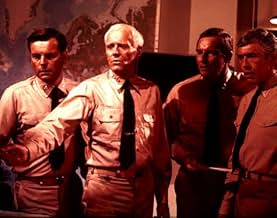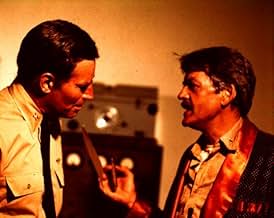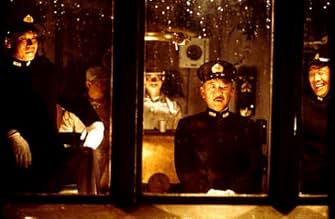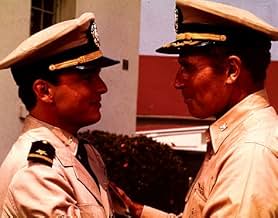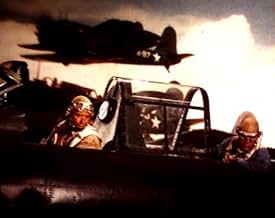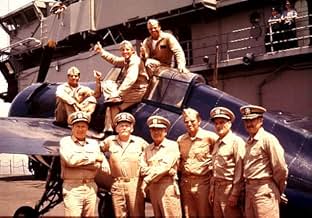Die Schlacht um Midway im Pazifik gilt gemeinhin Wendepunkt des Zweiten Weltkriegs.Die Schlacht um Midway im Pazifik gilt gemeinhin Wendepunkt des Zweiten Weltkriegs.Die Schlacht um Midway im Pazifik gilt gemeinhin Wendepunkt des Zweiten Weltkriegs.
Toshirô Mifune
- Admiral Isoroku Yamamoto
- (as Toshiro Mifune)
Handlung
WUSSTEST DU SCHON:
- WissenswertesKevin Dobson's character Ensign George Gay, was the sole survivor of Torpedo Squadron 8. Gay wrote a book about his experiences (Sole Survivor) and was an advisor on this film.
- PatzerWhen the cockpit of one of the planes catches fire, the pilot pulls out a fire extinguisher. It is a more modern one, not a fire extinguisher that would have existed in the 1940s.
- Zitate
Vice Adm. Chuichi Nagumo: [commenting on the American torpedo bombers] They sacrifice themselves like samurai, these Americans.
- Alternative VersionenA television version exists, with additional cast and plot. It runs four hours with commercials. The main plot points are a Charlton Heston-Susan Sullivan romance and the Coral Sea battle (reffered to in the other version) is played out like the Midway battle. The Coral Sea battle heavily features Mitchell Ryan as Admiral Aubrey Fitch and also includes a subplot where a young Japanese pilot who'd met with Admiral Nagumo to express his opposition to Japanese military action is shot down. At the end of the TV version, Sullivan and Christine Kukobo are both shown waiting dockside.
- VerbindungenEdited from Salute to the Marines (1943)
- SoundtracksIn the Mood
Music by Joe Garland
Performed by the Glenn Miller and His Orchestra (as Glenn Miller Orchestra) on the jukebox at the bar in Hawaii
Ausgewählte Rezension
Like "The Longest Day" and "Tora! Tora! Tora!", "Midway" follows the true story very closely and features an all star cast. And like the Longest Day, it features Henry Fonda, Robert Mitchum, and Robert Wagner. However, whereas the first two are war classics, Midway falls short in many departments.
For one, the movie seems to have no sense of building suspense. In the Longest Day, the paratrooper landings and the scenes of bombardment vessels creeping toward the shore let you know that all hell is about to break loose. Likewise, in Tora! Tora! Tora!, scenes of anxious commanders, desperate analysts, and the oblivious Hawaii residents are separated by scenes of approaching Japanese bombers to hike the suspense factor. Yet, despite the fact that Midway was the most decisive naval battle in modern history, we don't get a true sense of how important the pilots' jobs are or how grave the implications of the battle are, except for from titles before and after the movie. Where were the scenes of planes prepping for takeoff or of pilots, wary but dutiful about a mission that may be their last?
The battle sequences are another problem. First off, most of the footage is actual war footage or stock footage. The stock footage works fine for the bombing of Tokyo (since the shown footage is actually about that event) but is a little less convincing when the footage shown is supposed to be of Hawaii's Hickam Field but is passed off as Midway Island. Worse than the presence of stock footage is the editing. While maps of the ocean are shown repeatedly so that we know where the action is taking place, it's hard to tell what's what when we're away from the maps. We see planes crash into water and bombs explode, but most of the battle sequences could use a little more coherence. Had the makers of this movie shot a little combat footage of their own, even if only to make the battle scenes less jump, the movie would have benefitted.
For the most part, the cast is pretty good and fares well with only occasionally trite dialogue. However, only Heston, Holbrook, and Shigeta stand out. Many of the other players are simply not given enough time to make an impact. Coburn, especially, has little to do.
The flaws of this movie notwithstanding, it's still watchable, and it gives you a pretty good idea of the events and decisions leading up to the battle, as well as the errors and luck that went into the battle itself. And when you can't figure out what's happened from the uneven visuals, at least Nimitz (Fonda) or his at-sea commanders are there to describe what happened and add some perspective.
** out of ****
For one, the movie seems to have no sense of building suspense. In the Longest Day, the paratrooper landings and the scenes of bombardment vessels creeping toward the shore let you know that all hell is about to break loose. Likewise, in Tora! Tora! Tora!, scenes of anxious commanders, desperate analysts, and the oblivious Hawaii residents are separated by scenes of approaching Japanese bombers to hike the suspense factor. Yet, despite the fact that Midway was the most decisive naval battle in modern history, we don't get a true sense of how important the pilots' jobs are or how grave the implications of the battle are, except for from titles before and after the movie. Where were the scenes of planes prepping for takeoff or of pilots, wary but dutiful about a mission that may be their last?
The battle sequences are another problem. First off, most of the footage is actual war footage or stock footage. The stock footage works fine for the bombing of Tokyo (since the shown footage is actually about that event) but is a little less convincing when the footage shown is supposed to be of Hawaii's Hickam Field but is passed off as Midway Island. Worse than the presence of stock footage is the editing. While maps of the ocean are shown repeatedly so that we know where the action is taking place, it's hard to tell what's what when we're away from the maps. We see planes crash into water and bombs explode, but most of the battle sequences could use a little more coherence. Had the makers of this movie shot a little combat footage of their own, even if only to make the battle scenes less jump, the movie would have benefitted.
For the most part, the cast is pretty good and fares well with only occasionally trite dialogue. However, only Heston, Holbrook, and Shigeta stand out. Many of the other players are simply not given enough time to make an impact. Coburn, especially, has little to do.
The flaws of this movie notwithstanding, it's still watchable, and it gives you a pretty good idea of the events and decisions leading up to the battle, as well as the errors and luck that went into the battle itself. And when you can't figure out what's happened from the uneven visuals, at least Nimitz (Fonda) or his at-sea commanders are there to describe what happened and add some perspective.
** out of ****
Top-Auswahl
Melde dich zum Bewerten an und greife auf die Watchlist für personalisierte Empfehlungen zu.
- How long is Midway?Powered by Alexa
Details
Box Office
- Bruttoertrag in den USA und Kanada
- 43.220.000 $
- Eröffnungswochenende in den USA und in Kanada
- 4.356.666 $
- 20. Juni 1976
- Laufzeit2 Stunden 12 Minuten
- Farbe
- Seitenverhältnis
- 2.39 : 1
Zu dieser Seite beitragen
Bearbeitung vorschlagen oder fehlenden Inhalt hinzufügen

Oberste Lücke
By what name was Schlacht um Midway (1976) officially released in India in English?
Antwort

